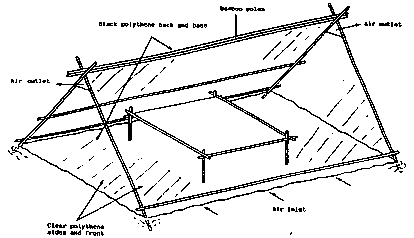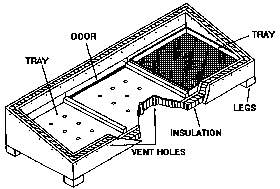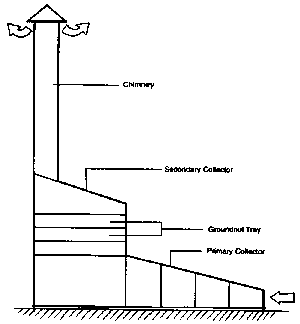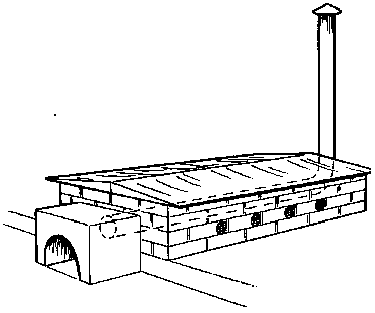How to Preserve Food with Small Scale Drying Technologies
Inhaltsverzeichnis
Übersicht
Übersicht übernommener Howtopedia Artikel, Zum Übersetzten Artikel , zum originale Artikel
Globally, drying is the most widely used method for preserving foods for use in the home or for sale. The most common method involves simply laying the product in the sun on mats, roofs or drying floors. This is known as sun drying. As shown below simple sun drying has advantages and disadvantages.
|
Advantages |
Disadvantages |
|
Almost without cost Ideal for products where little or no value is added Food usually dried close to the home |
Open to contamination by dust Totally dependent on good weather Very slow drying rates with danger of mould growth It may not be possible to dry to a sufficiently low level of moisture to prevent mould growth |
Sun drying remains, however, the only economic choice for poor people when drying foods such as grains in large quantities and where little or no value is added by drying.
When drying foods such as fruits, vegetables, spices, herbs and nuts value is added by drying and in such cases an investment in improved drying technologies may be economically viable. This technical brief describes improved systems suitable for use by small scale producers.
Solar dryers
Solar dryers use a simple construction to more efficiently make use of the sun's heat. Under the correct climatic conditions they can provide many advantages over sun drying. These include:
Higher drying temperatures which results in shorter drying times and the ability to dry to a lower final moisture content
Protection from contamination by dust and from rain showers
They are low cost and simple to construct in local workshops
Solar dryers consist of a transparent panel above a chamber or collector that is pained black to absorb the suns heat. Polythene, which is very cheap, is commonly used to glaze the panel but it turns yellow and opaque after a few months and needs to be replaced. Plastic films that are not damaged by sunlight are now increasing available and should be used if possible. While more expensive they have a life of 5 years or more. It is very important to angle the collector at the correct angle to the sun:
The angle should be greater than 15 to allow rain water to run off
The collector should be angled at 90 to the mid-day sun
The collector should face south in the Northern hemisphere and north in the Southern
The collector should be sited away from shadows from trees or buildings
Tent solar dryers, as shown in Figure 1, are cheap and simple to build and consist of a frame of wood poles covered with plastic sheet. Black plastic should be used on the wall facing away from the sun. The food to be dried is placed on a rack above the ground. Tent dryers provide protection against rain, insects and dust and, in the case of fish for example, can reduce drying times by 25%. Tent dryers can also be taken down and stored when not in use. They have the disadvantage of being easily damaged by strong winds
The Brace solar dryer as shown in Figure 2 has been widely used for small scale food drying. It consists of a wooden box with a hinged transparent lid. The inside is painted black and the food supported on a mesh tray above the dryer floor. Air flows into the chamber through holes in the front and exits from vents at the top of the back wall. Brace type dryers achieve higher temperatures, and thus shorter drying times, than tent dryers.
A further design of solar dryer uses of a separate solar collector which supplies heated air to a chamber containing trays of food. This is known as an indirect solar dryer and a typical design is shown in Fig 3. Dryers of this type have several advantages over direct dryers which include:
- the food is not exposed to the direct rays of the sun which reduces the loss of colour and vitamins
- the collector can be large and thus heat greater quantities of air
Indirect dryers are, however, more expensive and complex to construct.
The obvious problem with solar dryers is their inability to work when there is little or no sunlight. The McDowell dryer shown in Fig 4 attempts to overcome this problem by combining solar heat and heat from wood burning in a fire box. The Mc Dowell dryer consists of a block structure with a fire box at one end. Heat from the fire passes through a metal pipe below the tray of food and exits via a chimney. The whole structure supports a glazed solar roof.
Small Electric Dryers, as shown in Figure 5, can be constructed at a cost equal to or less than the solar dryers described above. Typically, such a dryer consists of a plywood box one metre cube, with a door to the front. Between 6 and 10 mesh trays are supported on wooden runners on the dryer walls. Heated air is supplied by a domestic 2kw fan heater to the rear base wall. The heater should be re-wired with an external thermostat (placed in the drying chamber) so that the heater elements are controlled by the thermostat while the fan runs all the time. This is a simple job that can be carried out by a competent electrician. The air exits via an opening at the top of the rear wall. The trays should be arranged so as to cause the air to follow a zig-zag path as it passes through the dryer as shown in Figure 5.
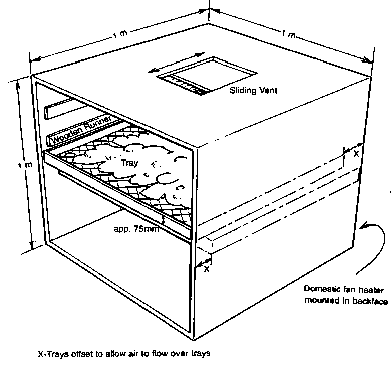
Figure 5: Small electric dryer. The air should follow a zigzag path.
Provided sufficient value is added by drying to cover electricity costs, such dryers offer distinct advantages over solar dryers which include:
- greater daily output
- higher drying temperatures and thus considerably more rapid drying
- faster drying due to the forced air flow
- total independence from weather conditions
- good control of the drying process
References and further reading
- Drying of foods, Practical Action Technical Brief
- Solar drying, Practical Action Technical Brief
- Drying of Chillies, Practical Action Technical Brief
- Drying of Apricots, Practical Action Technical Briefs
- Drying Food For Profit: A Guide for Small Business, Barrie Axtell, 2002, ITDG Publishing ISBN 1 85339520 X
- Setting up a Food Drying Business: A Step-by-step Guide, Fabrice Thuillier, 2002, ITDG Publishing, ISBN 1 85339 498 X
- Drying Foodstuffs, Jean Françoia Rozis, 1997, Backuys Publishers
This Howtopedia entry was derived from the Practical Action Technical Brief Energy from the Wind.
To look at the original document follow this link: http://
http://www.practicalaction.org/?id=technical_briefs_food_processing
Related Articles
- How to Preserve Food with Small Scale Drying Technologies
- How to Preserve Food by Drying
- How to Use Sun Power
- How to Make Chocolate
- How to Preserve Tomato
- How to Preserve Food with a Solar Dryer
- How to Process Spice
- How to Process Turmeric
- How to Build a Tray Dryer
- The Anagi Tray Dryer
- How to Dry Chillies
- How to Process Pepper
Usefull addresses
Practical Action
The Schumacher Centre for Technology & Development, Bourton on Dunsmore, RUGBY, CV23 9QZ, United Kingdom.
Tel.: +44 (0) 1926 634400, Fax: +44 (0) 1926 634401
e-mail:practicalaction@practicalaction.org.uk
web:www.practicalaction.org

Deeplink:
http://en.howtopedia.org/wiki/How_to_Preserve_Food_with_Small_Scale_Drying_Technologies
